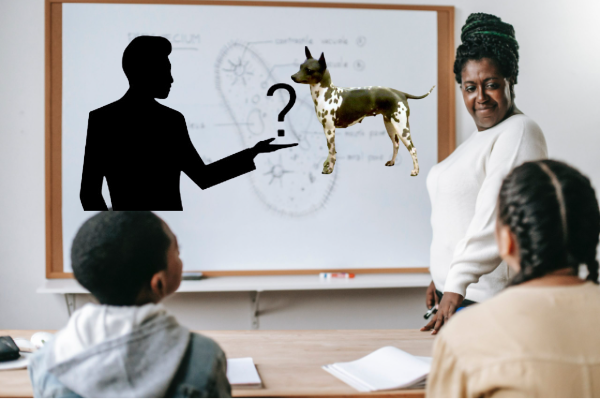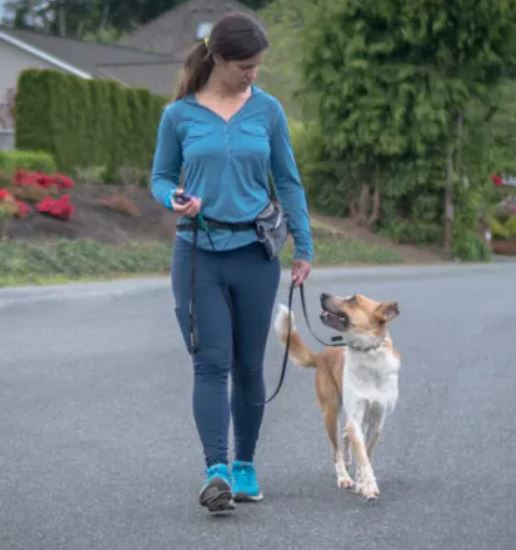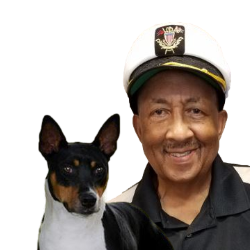This how to stop dog pulling on leash post contains affiliate links. Learn more on my Affiliate Disclosure page.
As a dog owner, one of the biggest challenges you may face is how to stop dog pulling on leash. It is aggravating and dangerous when walking your furry friend on a leash.
Not only can it cause discomfort for both you and your dog, but it can also lead to accidents and injuries. Throughout this article, I'll share three simple steps for how to stop dogs pulling on leash, as well as common mistakes to avoid and additional tips to reinforce good leash behavior in your dog.
Understanding Why And How to Stop Dogs Pulling On Leash
Before we dive into the steps on how to stop dogs pulling on leash it's vital to understand why dogs do it in the first place. Dogs are naturally curious and want to explore the world around them.
When dogs see something that catches their attention, they may pull toward it. Additionally, dogs may pull on the leash because they are excited or anxious.

How to Stop Dog Pulling on Leash
They may also pull to a particular place or person simply because they are not used to walking on a leash.
Dog Pulling on Leash May Cause INJURY
Dog pulling on the leash can be harmful in several ways.
- It can cause physical harm to both you and your dog, as well as damage to your relationship with your furry friend.
- Pulling on the leash, it can cause strain on its neck and back, leading to pain and discomfort. It can also cause injuries such as sprains and strains.
- Additionally, if your dog pulls too hard, it can cause you to lose your balance and fall, leading to potential injuries for you as well.
Moreover, a dog pulling on a leash can damage the relationship between you and your dog. For example, if you are constantly frustrated and stressed during walks, your dog may pick up on these negative emotions and become anxious or fearful.

As a result, you can lead to a breakdown in communication and trust between you and your furry friend.
Three Simple Steps For How to Stop Dog Pulling On Leash
Step 1: Choosing the Right Collar and Leash
The first step in how to stop dog pulling on leash is choosing a suitable collar and leash. A collar and leash that fit correctly and are comfortable for your dog can make a big difference in your dog's behavior.
There are several types of collars and leashes to choose from, including flat collars, choke chains, prong collars, and harnesses. Each has pros and cons, and selecting the one best for your dog's size, breed, and temperament is essential.
For example, a flat collar is a good option for dogs that don't pull too much. However, a harness may be a better choice if your dog is a strong puller.
Harnesses distribute the pressure across your dog's chest and back rather than just its neck. As a result, you can prevent injuries and discomfort caused by pulling. Whatever type of collar and leash you choose, ensure it fits properly and is comfortable for your furry friend.
Step 2: Loose Leash Dog Training
The second step is stopping your dog from pulling on the leash. You should start loose leash dog training early, teaching your dog how to walk on a loose leash.
First, you must teach your dog to walk beside you without pulling.

To do this:
- Start by taking short walks in a quiet area with few distractions.
- Keep the leash loose and walk at a steady pace. If your dog starts to pull, stop walking and wait for it to return to your side.
- When they do, reward them with a treat and praise.
Repeat this process several times, gradually increasing the distance and level of distraction. If your dog continues to pull, try changing direction or walking in a zigzag pattern to keep them focused on you.
Make sure to reward your dog whenever they walk beside you without pulling. Your dog will learn to walk on a loose leash with consistency and patience.
Step 3: Consistency and Patience in Stopping Dog Pulling
The third and final step in how to stop dogs pulling on leash is consistency and patience.
- Leash training takes time and effort, and it's essential to be patient and consistent.
- Practice every day, even if it's just for a few minutes at a time.
- To encourage good behavior, give treats and praise.
- It's also important to be consistent in your expectations. For example, if you allow your dog to pull on the leash sometimes but not others, it may need to be clarified for them to understand what you want.
- Set clear boundaries and stick to them.
Your dog will learn to walk on a loose leash and stop pulling with consistency and patience.
Common Mistakes to Avoid When Training Your Dog to Stop Pulling
When training your dog to stop pulling, there are several common mistakes to avoid.
- First, don't punish your dog for pulling. Punishment can lead to fear and anxiety, making the problem worse. Instead, positive reinforcement is a better way to encourage good behavior.
- Second, don't use a retractable leash. Retractable leashes can encourage pulling and make it difficult to control your dog. Instead, stick to a standard leash that allows you to control your dog's movements.
- Third, don't give up too soon. You must invest time and effort into training your dog to walk loosely on a leash. Keep going even if your dog learns right away. With patience and consistency, they will get there.
Additional Tips to Reinforce Good Leash Behavior in Your Dog
In addition to the three steps outlined above, you can use several additional tips to reinforce good leash behavior in your dog.
- First, make sure your dog gets plenty of exercises and mental stimulation. A tired dog is less likely to pull on the leash.
- Second, use a verbal cue, such as "heel" or "let's go," to signal to your dog that it's time to walk on a loose leash. Use the cue consistently, and reward your dog when it responds correctly.
- Third, practice walking your dog in different environments and with varying levels of distraction. Here you can reinforce good leash behavior in a variety of situations.
Need Training Help For Your Pet?
Do you need help in training your furry friend? Then, sign up for this fantastic (and free) online workshop on how to train your pet to become as well-behaved as a service dog.
K9 Training Institute Free Workshop
The K9 Training Institute offers a free workshop where you can learn firsthand their effective training methods.
The Free Workshop emphasizes building a solid bond between you and your pup. They explain how to apply positive reinforcement techniques that make learning enjoyable for dogs and their owners.
Does your dog tug on its leash, bark constantly, and won't come when called? Sign Up and get the FREE Obedience Training Workshop Now!
Conclusion and Final Thoughts on How to Stop Dog Pulling On Leash
Dog pulling on a leash can be a frustrating and even dangerous problem, but you can solve it with the right training and tools. You can stop your furry friend from pulling on the leash by choosing the right collar and leash, training your dog to walk on a loose leash, and being consistent and patient.
Remember to avoid common mistakes and reinforce good leash behavior with additional tips. Then, you and your dog can enjoy stress-free walks together with time and effort.




